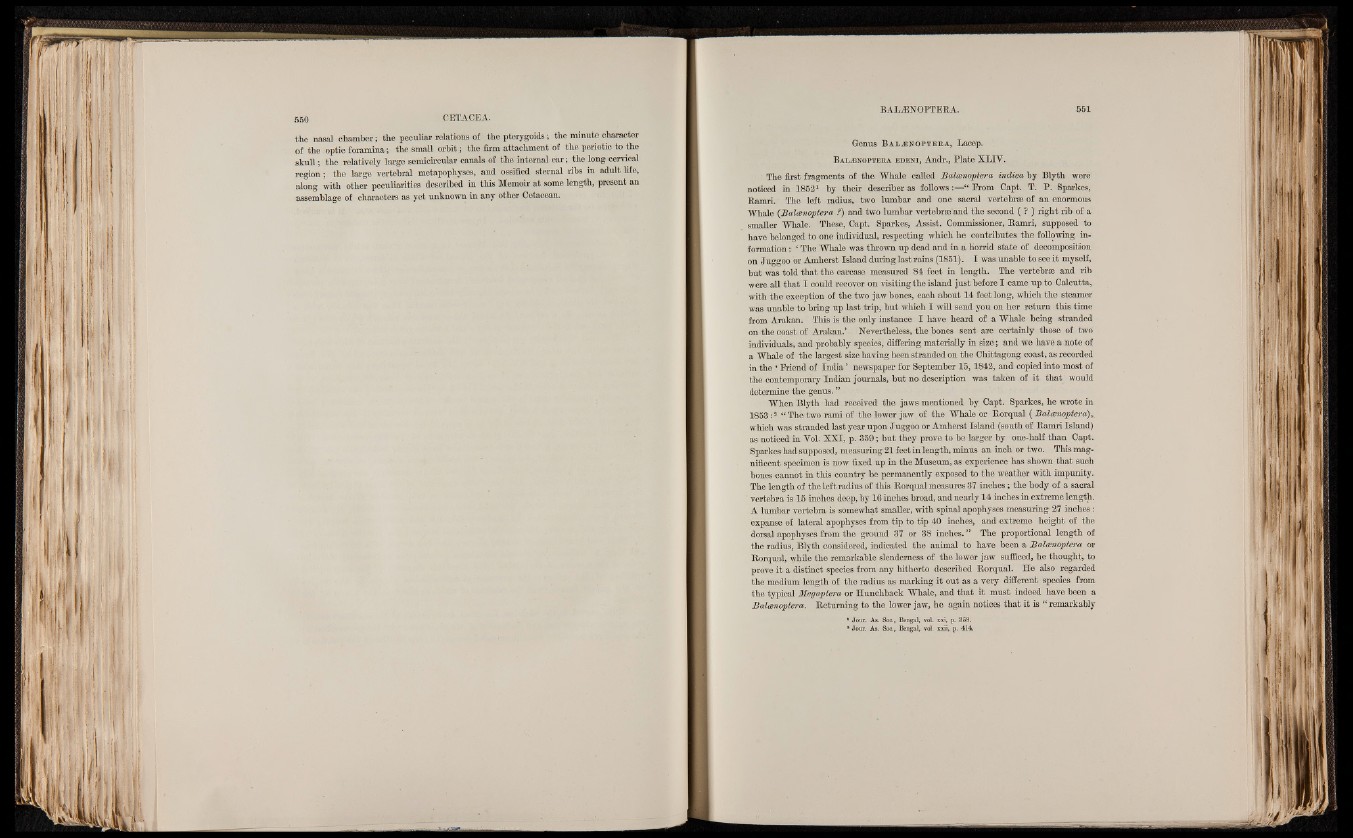
the nasal chamber; the peculiar relations of the pterygoids; the minute character
of the optic foramina; the small orbit; the firm attachment of the periotic to the
skull; the relatively large semicircular canals of the internal ear; the long cervical
region; the large vertebral metapophyses, and ossified sternal ribs in adult life,
along with other peculiarities described in this Memoir at some length, present an
assemblage of characters as yet unknown in any other Cetacean.
Genus B a l ^ n o p t b e a , Lacep.
B a l e e n o p t e r a e d e n i , Andr., Plate XLIY.
The first fragments of the Whale called Baleenoptera indica by Blyth were
noticed in 18521 by their describer as follows:—“ Erom Capt. T. P. Sparkes,
Ramri. The left radius, two lumbar and one sacral vertebrae of an enormous
Whale {Baleenoptera ?) and two lumbar vertebrae and the second ( ? ) right rib of a
smaller Whale. These, Capt. Sparkes, Assist. Commissioner, Ramri, supposed to
have belonged to one individual, respecting which he contributes the following information
: ‘ The Whale was thrown up dead and in a Horrid state of decomposition
on Juggoo or Amherst Island during last rains (1851). I was unable to see it myself,
but was told that the carcase measured 84 feet in length. The vertebrae and rib
were all that I could recover on visiting the island just before I came up to Calcutta,
with the exception of the two jaw bones, each about 14 feet long, which the steamer
was unable to bring up last trip, but which I will send you on her return this time
from Arakan. This is the only instance I have heard of a Whale being stranded
on the coast of Arakan.’- Nevertheless, the bones sent are certainly those of two
individuals, and probably species, differing materially in size; and we have a note of
a Whale of the largest size having been stranded on the Chittagong coast, as recorded
in the ‘Eriend of India ’ newspaper for September 15,1842, and copied into most of
the contemporary Indian journals, but no description was taken of it that would
determine the genus. ”
When Blyth had received the jaws mentioned by Capt. Sparkes, he wrote in
1853:2 “ The two rami of the lower jaw of the Whale or Rorqual ( Baleenoptera),v
which was stranded last year upon Juggoo or Amherst Island (south of Ramri Island)
as noticed in Vol. XXI, p. 359; but they prove to be larger by one-half than Capt.
Sparkes had supposed, measuring 21 feet in length, minus an inch or two. This magnificent
specimen is now fixed up in the Museum, as experience has shown that such
bones cannot in this country be permanently exposed to the weather with impunity.
The length of the left radius of this Rorqual measures 37 inches; the body of a sacral
vertebra is 15 inches deep, by 16 inches broad, and nearly 14 inches in extreme length.
A lumbar vertebra is somewhat smaller, with spinal apophyses measuring* 27 inches :
expanse of lateral apophyses from tip to tip 40 inches, and extreme height of the
dorsal apophyses from the ground 37 or 38 inches. ” The proportional length of
the radius, Blyth considered, indicated the animal to have been a Baleenoptera or
Rorqual, while the remarkable slenderness of the lower jaw sufficed, he thought, to
prove it a distinct species from any hitherto described Rorqual. He also regarded
the medium length of the radius as marking it out as a very different species from
the typical Megaptera or Hunchback Whale, and that it must indeed have been a
Baleenoptera. Returning to the lower jaw, he again notices that it is “ remarkably
1 Jour. As. Soc., Bengal, vol. xxi, p. 358.
* Jour. As. Soc., Bengal, vol. xxii, p. 414.